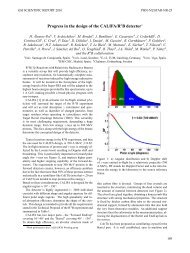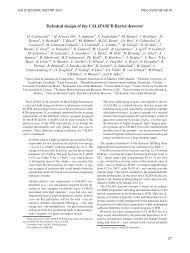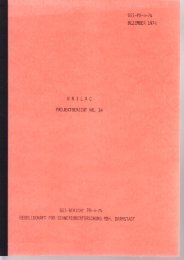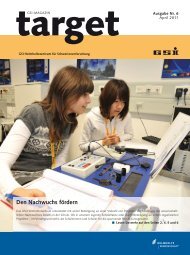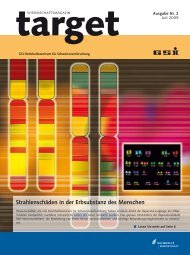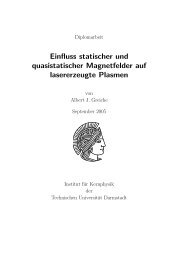download block - GSI Helmholtzzentrum für Schwerionenforschung
download block - GSI Helmholtzzentrum für Schwerionenforschung
download block - GSI Helmholtzzentrum für Schwerionenforschung
Create successful ePaper yourself
Turn your PDF publications into a flip-book with our unique Google optimized e-Paper software.
<strong>GSI</strong>-UPGRADE-ACC-13 <strong>GSI</strong> SCIENTIFIC REPORT 2009<br />
158<br />
<strong>GSI</strong>Template2007<br />
Chemical stripping of bulk saturated NEG coatings<br />
M. Wengenroth 1 , H. Kollmus 1 , M. C. Bellachioma 1 , S. Sievers 2 , J. Conrad 2 , M. Bender 1 ,<br />
and H. Reich-Sprenger 1<br />
1 <strong>GSI</strong>, Darmstadt, Germany; 2 TU, Darmstadt, Germany<br />
Introduction<br />
In the recent years the installation of non-evaporable<br />
getter (NEG) coated dipole and quadrupole chambers at<br />
the <strong>GSI</strong> heavy ion synchrotron (SIS 18) have been carried<br />
out and ware completed in January 2010. The NEG<br />
coated chambers was part of different upgrade activities<br />
of the existing UHV system [1]. Those non-evaporable<br />
thin film getters, consisting of Ti–Zr–V, are deposited<br />
onto the vacuum chambers using three magnetron sputtering<br />
facilities built at <strong>GSI</strong>, each fulfilling different geometric<br />
shapes and dimensions. A detailed description of the<br />
production and the functional principle is given in<br />
Ref [1]. In brief, after coating and activation a highly<br />
chemical reactive surface is present in the vacuum system<br />
getting dissociated residual gas components by means of<br />
oxidation, nitration and carbonisation of the surfaces metallic<br />
constituents. The capacity of the NEG surface is<br />
approximately one monolayer for CO and CO2 (10 15 particles<br />
per cm 2 ). In the environment of the SIS18 the operation<br />
time of an activated NEG surface is typically<br />
longer compared to the venting cycle time due to maintenance.<br />
The live time capacity of a 1 µm NEG thin film is<br />
limited to 30 – 50 reactivations [2].<br />
After the bulk of the NEG film is completely saturated,<br />
it has to be stripped of the vacuum chamber before applying<br />
new NEG coating. Industrial stainless steel pickling<br />
utilizing solutions containing nitric and hydrofluoric acid<br />
similar to buffered chemical polishing (BCP) [3] has<br />
proven to work on thick walled chambers (>2 mm) [4] but<br />
is not feasible for delicate dipole and quadrupole chambers<br />
of only 0.3 mm wall thickness because of nonuniformities<br />
especially at welded joints. Therefore, an<br />
alternative method was proven and will be described in<br />
the following.<br />
Experimental procedure<br />
Briefly, the chemical material removal is obtained by<br />
an oxidation of the metallic constituents through the nitric<br />
acid and the dissolution of these oxides by the hydrofluoric<br />
acid. Performing those steps sequentially will considerably<br />
reduce the risk of damaging a delicate chamber<br />
permanently. Accordingly NEG coated samples have<br />
been treated at the cleaning facility for superconducting<br />
niobium RF cavities of S-DALINAC (Superconducting<br />
Darmstadt Linear Accelerator). The oxidation is done by<br />
immersing the samples into nitric acid (65 %) for<br />
5 minutes followed by the removal of the oxides by immersing<br />
into hydrofluoric acid (40 %) for 1 minute. Five<br />
coated samples have been treated employing the above<br />
sequence one to five times.<br />
Measurements<br />
The results of the etching were investigated using proton<br />
Rutherford Backscattering Spectroscopy (RBS) at the<br />
ion beam analysis department of the Forschungszentrum<br />
Dresden-Rossendorf and shown in Fig. 1, were the energy<br />
distribution of the backscattered protons is displayed.<br />
Highest proton energies are achieved for collision with Zr<br />
and only observed for the untreated sample (compare red<br />
line in Fig. 1). This means that after the first treatment the<br />
approx 1 µm NEG film was already completely removed.<br />
counts<br />
1000<br />
100<br />
1. treatment<br />
2. treatment<br />
3. treatment<br />
4. treatment<br />
5. treatment<br />
NEG<br />
10<br />
600 700 800<br />
energy [arb. units]<br />
Figure 1: The energy distribution of the backscattered<br />
protons shows the highest energies from collisions with<br />
Zr only for the untreated NEG sample.<br />
Conclusion<br />
A method of stripping a saturated NEG film from thin<br />
wall chambers has been proven. Nevertheless, nitric and<br />
especially hydrofluoric acid can’t be handled without introducing<br />
certain safety measures.<br />
References<br />
[1] M.C. Bellachioma, et al., Vacuum 82 (2008), p. 435<br />
[2] P. Chiggiato and P. Costa Pinto,<br />
Thin Solid Films 515 (2006) p. 382<br />
[3] B. Aune, et al., Phys. Rev. ST-AB, 3, 092001 (2000)<br />
[4] M. Wengenroth, Internal Report (2009)<br />
Acknowledgements<br />
The authors would like to thank M. Brunken of the<br />
S-DALINAC accelerator group for his support and<br />
R. Grötzschel (FZ Dresden-Rossendorf) and W. Assmann<br />
(LMU Munich) for performing the RBS analysis at the FZ<br />
Dresden-Rossendorf.





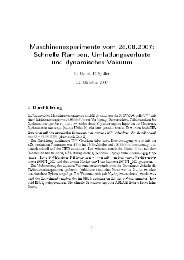
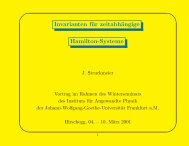
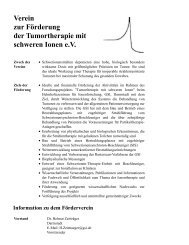
![GS I -P-]-17 - GSI Helmholtzzentrum für Schwerionenforschung](https://img.yumpu.com/20698964/1/184x260/gs-i-p-17-gsi-helmholtzzentrum-fur-schwerionenforschung.jpg?quality=85)

